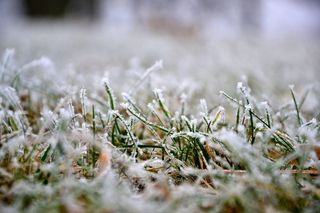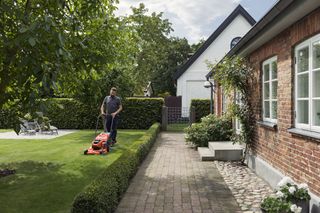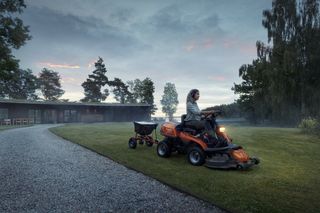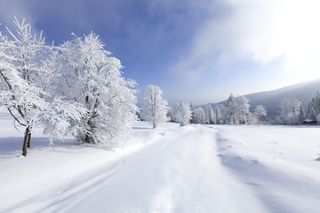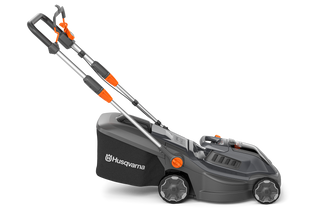Do you need battery solutions with even higher performance and durability? Then Husqvarna's BLi-X 36V battery system is the perfect choice. It delivers pro-level performance and is suitable for homeowners and professional users who carry out everything from light to demanding garden and land tasks. One battery can be used for several tools, and the wide range of options, from lightweight integrated to backpack batteries, makes it easy to find a tailored, powerful solution that perfectly suits your task at hand.
Garden Calendar – checklist of tasks for your garden
What's on this page?

There's always something to do in the garden. But when is the best time to complete certain tasks? Here in our Garden Calendar you'll get the best tips of what tasks you should concentrate on each month.
12 months
January
- New year, time for new plans! Now is the time to start dreaming and planning all garden projects for next spring - and if you're dreaming of a lawn that basically takes care of itself, it may be time to start thinking now about which robotic mower suits your lawn so it can be installed and ready to go when the grass starts growing.
- If you live where there’s snow, pay attention to how much there is - a moderately thick blanket can protect plants and shrubs, but if it gets too heavy and wet, there is a risk that the weight of the snow will break some branches and stems. Gently shake off the snow from branches and shrubs if you see them starting to hang too much under the weight. Protect young plants and shrubs from small hungry animals and snow by packing the snow around the base of the plant, so they can’t get underneath the protective covers/sheets put in place. This will also keep your plants protected from winter frost.
- If the damage has already been done, you can purchase healing balm to apply to the trunk or stems.
- Grass is fragile in frost and cold conditions, so avoid walking too much on the lawn or placing large amounts of snow there if clearing paths. Did you forget to prune the apple or pear trees last autumn? If you are careful and do it correctly, both pear and apple trees can usually be pruned this time of year without causing too much sap. Learn how to prune a tree.
February
- Planning for next season is up and running, you will slowly start to see your garden come to life again in February. Now is the time to check over the mower and send it for repair if necessary.
- There is usually a long line at the workshop in spring so be prepared before the grass starts growing, and beat the rush at your local garden machinery dealership.
- February is the perfect time to think about protecting sensitive plants and shrubs such as white cedar and boxwood from the spring sun by covering them with twigs from the Christmas tree, or hessian fabric, to prevent them from “waking up” from their Winter hibernation too early, and trying to draw water from the frozen soil.
- If perennials emerge from the ground now, cover them with autumn leaves or twigs for extra protection from the frost. Cutting back and mulching borders can be carried out in February if not already done in winter.
March
- Check your lawn – is there a lot of moss? If so, rake it away carefully and top dress (or use fine sand if there is a lot of moss).
- Once the snow has disappeared and the temperature is between 10 and 15°C, you can start fertilising your lawn. Lay out the fertiliser when it's raining. A good rule of thumb is to fertilise your lawn a little every 4-5 weeks with a larger amount every 6-8th week.
- As long as buds have not started sprouting on apple and pear trees, they can be pruned now. The same applies to hedges.
- If the spring sun is strong even though there is still frost in the soil, it’s good to protect evergreens with hessian to avoid a too early awakening. You can also water with warm water on evergreen plants as the frost will then thaw and the plant can start to draw water again.
- Once the flower beds have started to sprout again, you can cut away anything that has withered and place it in the garden compost.
- If there is a lot of brushwood in the garden that needs to be removed, a clearing saw is an effective tool to use. Learn more about clearing saws.
April
- Start looking for weeds and dig them up by the roots.
- If the lawn is slightly worn, it is a good idea to sow new grass where needed or to distribute grass seed evenly over the entire lawn for best results. Keep the surface moist and cover with a fibre cloth for faster germination. If it's a dry spring, it's also time to start watering your lawn now.
- Take out your lawn mower and other gardening tools and make sure they are in good working order. Clean, use rust remover where necessary, and oil in wooden handles. Does anything need to be repaired or the blades sharpened? Maybe it's time to buy a new one? If you are considering buying a robotic lawn mower for the season, our guide can recommend which model is suitable for your lawn.
- Do you have a robotic mower? Make sure you freshen it up for the season, that the battery is fully charged, and new sharp blades are fitted to get a nice cutting result without split ends.
- Fertilise and improve the soil with compost around bushes and in beds. It's also time to prune herbs like lavender, and once the birch has started to leave, it's the turn of the roses.
- To provide bees with food, you can exclude the area where your spring flowers are growing with temporary robot boundary fences or stay-out zones, to prevent your robotic lawn mower from cutting the flowers. Learn more about zone control.
May
- Grass starts growing at around 8°C and it's time to start mowing but wait until it's over 5 cm long before you start. Keep in mind that grass thrives best when it's cut about 1/3 of its length at any time, so mow the lawn at regular intervals. Robotic mowers do the hard work for you and mow little and often, so you don’t have to worry about when to cut the grass.
- A lawn thrives best when it’s aerated to be dense and fine. Aerating helps to oxygenate the grass and improve drainage; water and nutrients penetrate to the roots and the grass grows more shoots. Do not do this too early as you risk damaging the grass while it’s sensitive but wait until the grass has come to life and you have mowed a couple of times. If you have a robotic lawn mower, remember to mark where the guide cable is located to avoid boundary wire breakage.
- Now is the best time to plant new trees and bushes.
June
- The garden is now in full bloom and very green, the lawn should be mowed about once a week at this time.
- Support high perennials with sticks or stands so they do not collapse under rain or the weight of its flowers. Cut off wilted flowers and usually new flowers will grow.
- Water newly planted bushes and trees.
- Prune a spruce hedge during June or July. Now is the perfect time to do some topiary on your hedges. Use a string to help you create a very straight hedge. Fertilise bushes and perennials a second time toward the end of June.
July
- Don’t forget watering and make sure your new plantings don’t dry out. Start watering when the grass changes to dark green to avoid a dried out lawn. If it’s been a very dry start of the summer, it is a good idea to water a little extra if possible. Water preferably in the morning so that there is less evaporation and avoid watering in short periods that will cause superficial roots.
- Thin fruit trees and support hanging branches so that they do not risk being broken under the weight of fruit.
August
- The pruning period (August, September) has begun, so now is a good time to prune most trees and bushes. Check out Husqvarna pruners.
- Start with fruit tree water shoots and the branches growing inward.
- Thinning fruit trees also produces bigger and better fruit.
- A battery-powered pole saw is a good tool for reaching high into the branches of a tree and is easy to handle.
- Thin and rejuvenate hedges and bushes that have finished blooming.
- Sowing grass in August is effective. The seeds germinate quickly in the heat and the soil and air are moist enough to prevent the seeds from drying out. Newly sown grass should be watered little and often and frequently, and an established lawn should be watered less frequently and liberally so that the water penetrates deeply.
- Thin currant and gooseberry bushes after harvesting. Remove stunted, scrubby and intersecting branches to allow air and light to enter the bushes. Also, thin raspberry bushes and remove all the shoots where the berries have been.
- Dig up and split flowering spring perennials if they have become big and you want to multiply them.
- If you have a deciduous hedge, such as a spiraea, hawthorn or snowberry, it's time to trim it and a good time to trim topiary shrubs.
September
- During September-November we recommend fertilising your lawn with autumn fertiliser (nitrogen content 3–6%) a few weeks before the first frost for best effect. This makes the grass resistant to cold in winter and will give it more growing power this spring.
- Harvest fruit trees and remove windfalls from the lawn. The best time to prune fruit trees is when you have finished harvesting. Also remove fruit mummies still in the trees as they may have contagious fungal diseases.
- Now is also a good time for new planting, such as flowerbeds, trees and bushes.
- If you’re thinking about a new lawn, September is a good time for this too.
- Now is a good time to aerate again.
October
- Now it's time to close down the garden. Give the lawn one last mow. Raise the cutting height slightly the last few times so that the grass is strong enough for the winter and snow.
- Bring in your outdoor furniture and potted plants – the night frost can come suddenly and harm both plants and pots.
- Collect the leaves on the lawn and put them in the compost or use them to protect sensitive plants. Leaving a thick carpet of leaves on the lawn increases the risk of moss and mold, so clear the lawn as much as possible before the winter. A leaf blower makes the job quick and easy.
November
- Most things not done in October can still be done in November depending on your living situation. If the snow has not yet arrived and frost stays away, there is still time to rake to avoid away from the lawn or prepare for planting hedges, trees or bushes by digging up space for when spring arrives.
- Place the robotic mower in winter storage or send it to one of our authorised Husqvarna dealers for service and winter maintenance. Remember the robotic mower battery must be fully charged and kept frost-free during winter storage. Smart wall hangers are available that make it easy to hang them + the charging station up during the Winter and we also have a cleaning kit if you want to clean the mower after a long season.
- If you have battery products, we recommend charging the battery to 50% before winter for a longer life. Batteries are best stored warm in 5–25° C.
- Tidy up the entrance and plant evergreens such as ivy, boxwood, spruce or cypresses in large pots.

Charge up with your battery products
Are you looking for garden tools with low noise, minimal need for maintenance, and no direct emissions of CO2 during use? Discover the Husqvarna battery series, and you will find a wide range of high-performing, easy-to-use products for all needs. The optimal battery solution for home and garden tasks is the 18V POWER FOR ALL ALLIANCE system. One battery can be used for several tools and brands, which allows great flexibility and less storage. Husqvarna's 18V batteries have been optimised for our Aspire™ tools to ensure improved power and efficient run time and to suit a variety of DIY projects in your garden.
In addition, the compact battery size and the low weight facilitate usability, making every task more convenient and efficient.
Recommended products
(4)
